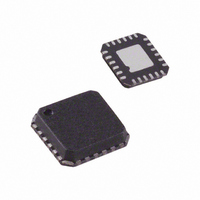AD8341ACPZ-WP Analog Devices Inc, AD8341ACPZ-WP Datasheet - Page 11

AD8341ACPZ-WP
Manufacturer Part Number
AD8341ACPZ-WP
Description
IC MOD VECT 1.5-2.4GHZ 24LFCSP
Manufacturer
Analog Devices Inc
Datasheet
1.AD8341ACPZ-REEL7.pdf
(20 pages)
Specifications of AD8341ACPZ-WP
Function
Vector, Modulator
Lo Frequency
1.5GHz ~ 2.4GHz
Rf Frequency
1.5GHz ~ 2.4GHz
P1db
8.5dBm
Noise Floor
-150.5dBm/Hz
Current - Supply
145mA
Voltage - Supply
4.75 V ~ 5.25 V
Test Frequency
1.9GHz
Package / Case
24-VFQFN, CSP Exposed Pad
Lead Free Status / RoHS Status
Lead free / RoHS Compliant
I-Q ATTENUATORS AND BASEBAND AMPLIFIERS
The proprietary linear-responding attenuator structure is an
active solution with differential inputs and outputs that offer
excellent linearity, low noise, and greater immunity from mis-
matches than other variable attenuator methods. The gain, in
linear terms, of the I and Q channels is proportional to its control
voltage with a scaling factor designed to be 2/V, i.e., a full-scale
gain setpoint of 1.0 (−4.5 dB) for a V
control voltages can be driven differentially or single-ended. The
combination of the baseband amplifiers and attenuators allows
for maximum modulation bandwidths in excess of 200 MHz.
OUTPUT AMPLIFIER
The output amplifier accepts the sum of the attenuator outputs
and delivers a differential output signal into the external load.
The output pins must be pulled up to an external supply,
preferably through RF chokes. When the 50 Ω load is taken
differentially, an output P1dB and IP3 of 8.5 dBm and 17.5 dBm
is achieved, respectively, at 1.9 GHz. The output can be taken in
single-ended fashion, albeit at lower performance levels.
NOISE AND DISTORTION
The output noise floor and distortion levels vary with the gain
magnitude but do not vary significantly with the phase. At the
higher gain magnitude setpoints, the OIP3 and the noise floor
vary in direct proportion with the gain. At lower gain magni-
tude setpoints, the noise floor levels off while the OIP3
continues to vary with the gain.
BBI
(or a V
BBQ
) of 500 mV. The
Rev. 0 | Page 11 of 20
GAIN AND PHASE ACCURACY
There are numerous ways to express the accuracy of the
AD8341. Ideally, the gain and phase should precisely follow the
setpoints. Figure 4 illustrates the gain error in dB from a best fit
line, normalized to the gain measured at the gain setpoint = 1.0,
for the different phase setpoints. Figure 6 shows the gain error
in a different form, normalized to the gain measured at phase
setpoint = 0°; the phase setpoint is swept from 0° to 360° for
different gain setpoints. Figure 8 and Figure 22 show analogous
errors for the phase error as a function of gain and phase
setpoints. The accuracy clearly depends on the region of opera-
tion within the vector gain unit circle. Operation very close to
the origin generally results in larger errors as the relative
accuracy of the I and Q vectors degrades.
RF FREQUENCY RANGE
The frequency range on the RF input is limited by the internal
polyphase quadrature phase-splitter. The phase-splitter splits
the incoming RF input into two signals, 90° out of phase, as
previously described in the RF Quadrature Generator section.
This polyphase network has been designed to ensure robust
quadrature accuracy over standard fabrication process
parameter variations for the 1.5 GHz to 2.4 GHz specified RF
frequency range. Using the AD8341 as a single-sideband modu-
lator and measuring the resulting sideband suppression is a
good gauge of how well the quadrature accuracy is maintained
over RF frequency. A typical plot of sideband suppression from
1.1 GHz to 2.7 GHz is shown in Figure 28. The level of sideband
suppression degradation outside the 1.5 GHz to 2.4 GHz speci-
fied range will be subject to manufacturing process variations.
–15
–20
–25
–30
–35
–40
–45
0.7
Figure 28. Sideband Suppression vs. Frequency
0.9
1.1
1.3
FREQUENCY (GHz)
1.5
1.7
1.9
2.1
2.3
2.5
AD8341
2.7













